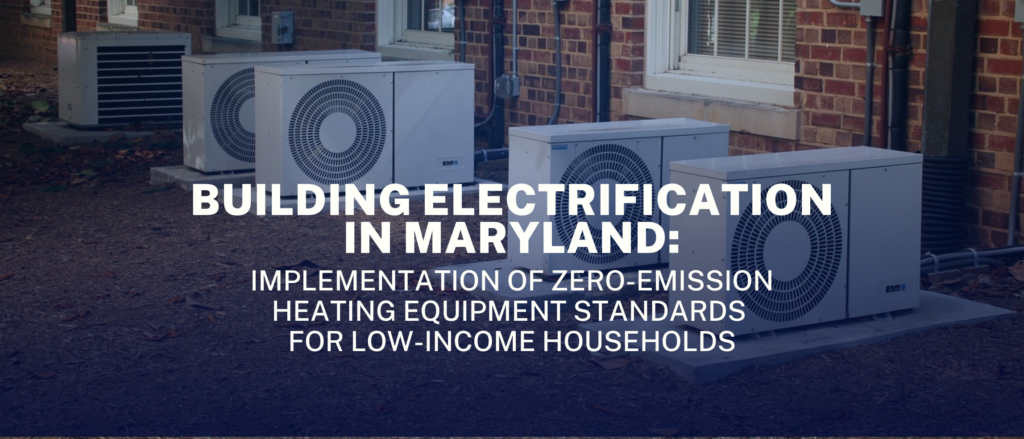In the past year, Maryland residents have seen their heating bills skyrocket, which has largely been tied to increased costs of methane gas distribution. These costs are expected to worsen as increased spending on the distribution system must be repaid over the next several decades.
At the same time, greenhouse gas emissions from burning fossil fuels in the home contribute substantially to climate change, and pollution from fossil fuel heating also has a substantial impact on residents’ health.
The Maryland General Assembly, Governor Wes Moore, and the Maryland Public Service Commission have taken some important initial steps to address these problems. However, long-term cost increases for fossil fuel-based heating remains a pressing concern for Marylanders — particularly those already facing significant energy burdens.
In a new report published today, we explore policies designed to tackle these challenges and provide analysis and recommendations on how to make the transition to updated heating technologies and building electrification more equitable and effective for low-income Marylanders.
The good news is that Maryland is already hard at work in this area. In June 2024, Moore issued an executive order that directed the Maryland Department of the Environment (MDE) to develop a zero-emission heating equipment standard (ZEHES). MDE is currently evaluating proposed regulations for ZEHES, which are scheduled to take effect in 2029.
Although the details of the regulations are still under consideration, they will likely require the replacement of pollution-emitting gas, propane, and oil-fired heating equipment with non-emitting heat pumps at the end of the emitting equipment’s life.
This has two important practical effects: First, building owners are not forced to “eat” the lost value of their functional equipment, and second, implementation will occur over the lifespan of the most recently installed equipment, resulting in gradual implementation through the 2050s.
However, as with all policy, the devil is in the details, and the number of units to be replaced yearly, the costs, and the benefits all should be weighed. In assessing these details, the Maryland Chapter of the Sierra Club and the Center for Progressive reform conducted research and modeling to evaluate these variables and help MDE, other Maryland agencies, and the public pursue equitable implementation of ZEHES, lower costs to the public and the state, and maximize the energy, health, and greenhouse gas reduction benefits of the program.
Because this analysis looks at equitable implementation of ZEHES, the resulting report focuses on low-income households in the state (under 80 percent area median income). These households are both the most likely to require funding to achieve the transition to clean heating and are the most vulnerable to being “left behind” if the program is not instituted equitably.
Topline takeaways include:
- More than 45,000 housing units will require replacement of a furnace or other fossil fired air heating equipment per year, and more than 73,000 will require a water heater replacement per year. For low-income households, this means replacing nearly 14,000 air heating units and more than 21,000 water heaters per year.
- Costs are not insubstantial. For low-income household replacements, upfront costs could reach close to $300 million annually (with an additional $80 million for weatherization, should that be conducted simultaneously) — or approximately $185 million of incremental costs (the difference in cost between a legacy fossil fuel system and a modern, efficient, clean system).
- This spending will create a significant return on investment for Marylanders. Once replacements are complete, the total energy, health, and climate savings will total $800 million per year, making ZEHES an excellent investment over time.
- For households, energy savings vary based on the existing heating fuel source (gas, propane, fuel oil, or electricity) and the time at which the replacement occurs. Through 2029, there are marginal energy savings for gas. However, as gas prices continue to increase, switching from gas by the early to mid-2030s will generate meaningful savings for households.
The upshot is that ZEHES will accomplish three things: reduce high energy bills every year going forward, address negative health impacts, and help meet Maryland’s greenhouse gas reduction targets. To be successful, the state must make funding available — especially for low-income households.
By maximizing investment from dedicated funds, Maryland can achieve this without adding stress to the general fund. Specifically, by leveraging monies from the Strategic Energy Investment Fund (SEIF) for electrification, equitably making full use of the EmPOWER fund (which has been underspending its yearly budget) and ensuring that the 40 percent of residential spending goes to low-income households (up from 22 percent today) , and capitalizing climate finance entities to support electrification, Maryland can pay for the initial costs of electrification for low income households under ZEHES — and ultimately result in a major return on investment for the state.
Prior to 2029, Maryland can and should maximize investment in heat pump installation for homes with propane, heating oil, and electric resistance heating as these homes would see the greatest energy savings during that time period. Although focusing on electric heating (not covered by ZEHES) may seem somewhat counterintuitive, it represents a pathway for individual homeowners to see the greatest heating cost savings in the near-term. It would also build Maryland’s capacity to implement electrification programs and drive a market transformation that will reduce costs for installation, making ZEHES substantially more achievable in 2029. Trials of lower-cost window heat pumps and heat pump installation without weatherization may further lower the cost of the transition.
Through an equitable approach to ZEHES, and building momentum for the 2029 implementation now, Maryland can, and will, achieve a cleaner, healthier, and far more affordable energy future.

